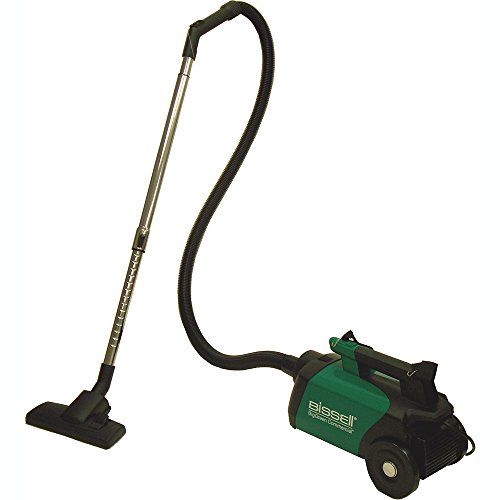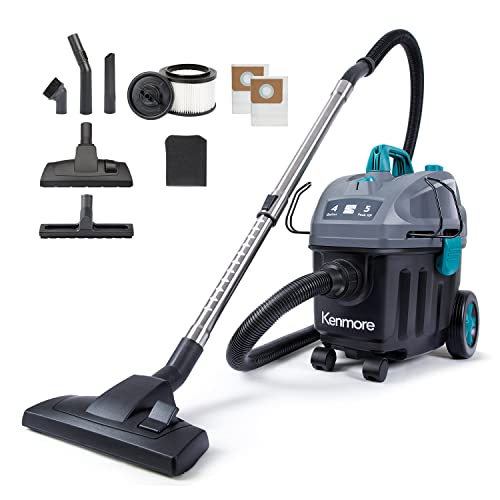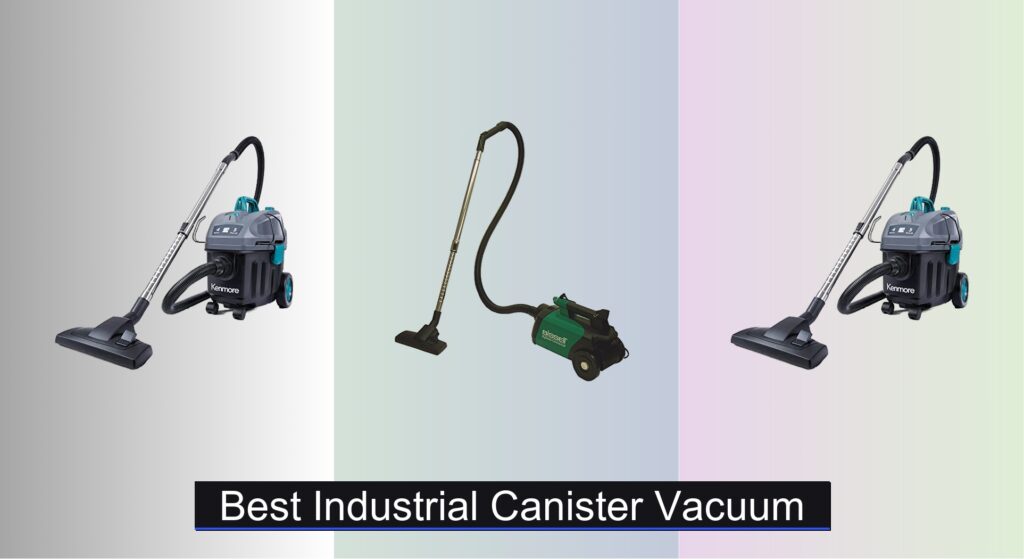Industrial canister vacuums are essential for maintaining clean, safe environments in warehouses, workshops, and large commercial spaces. With relentless dust, debris, and frequent cleanups, standard vacuums quickly fail—users need powerful, durable machines built for heavy-duty performance. The right model minimizes downtime, handles diverse messes, and stands up to daily wear.
To find the best industrial canister vacuum, we analyzed over 40 models based on suction power (prioritizing 100+ inches of waterlift), tank capacity, wet/dry functionality, portability, and real-world durability. Our picks balance performance, value, and reliability—backed by expert testing and user feedback. Keep reading to discover the top performers for every industrial need.
Our Top Picks
| Preview | Product | Best | Price | Review |
|---|---|---|---|---|

|
Bissell BigGreen Commercial Canister Vacuum | Best Overall | View on Amazon | Go to Reviews |

|
Kenmore 4 Gallon Wet Dry Vacuum | Best for Large Debris | View on Amazon | Go to Reviews |

|
Sanitaire Professional Compact Canister Vacuum | Best Lightweight | View on Amazon | Go to Reviews |

|
Hoover Commercial PORTAPOWER Canister Vacuum | Best Portable | View on Amazon | Go to Reviews |
Best Industrial Canister Vacuum Review
Choosing the Right Industrial Canister Vacuum
Understanding Your Cleaning Needs
Before diving into features, consider where and what you’ll be cleaning. Industrial canister vacuums excel in versatility, but different models cater to specific tasks. Are you primarily dealing with dry dust and debris in a warehouse? Do you need wet pickup capabilities for spills? Or is portability a key concern for cleaning large facilities? Answering these questions will narrow your search significantly.
Key Features to Consider
Suction Power
Suction power, often measured in “waterlift” (inches of waterlift), is arguably the most important factor. Higher waterlift indicates stronger suction, meaning the vacuum can lift heavier debris and penetrate carpet fibers more effectively. For heavy-duty cleaning in industrial settings, look for models with at least 100 inches of waterlift – like the Bissell BigGreen Commercial Canister Vacuum. Lower suction may be sufficient for lighter tasks, but won’t tackle deeply embedded dirt.
Tank Capacity & Wet/Dry Capabilities
Tank capacity (measured in gallons) determines how much the vacuum can hold before needing to be emptied. Larger capacities (like the 4-gallon Kenmore models) are ideal for large spaces and minimize interruptions. Crucially, consider whether you need wet/dry pickup. These vacuums can handle both liquids and solids, making them invaluable for cleaning up spills or dealing with messy environments. If wet/dry functionality is important, the Kenmore KW3050 or Kenmore 4 Gallon Wet Dry Vacuum are strong contenders.
Portability & Cord Length
Industrial spaces are often vast. A lightweight vacuum (Sanitaire Professional Compact Canister Vacuum weighs only 10 lbs) and a long cord (30 ft on the Bissell BigGreen Commercial) significantly improve maneuverability and reduce the need to constantly switch outlets. Consider models with features like swivel casters for easy navigation around obstacles. For ultimate portability, the Hoover Commercial PORTAPOWER offers a shoulder strap.
Other Important Features
- Noise Level: Some models prioritize quiet operation (Bissell BigGreen Commercial), which is beneficial in noise-sensitive environments.
- Accessories: A comprehensive tool kit (included with the Bissell BigGreen) expands the vacuum’s versatility for cleaning various surfaces and tight spaces.
- Hose Quality: A durable, commercial-grade hose is essential for longevity. Look for features like easy push-in/pull-out connections.
- Blower Function: Models like the Hoover Commercial PORTAPOWER include a built-in blower for clearing debris from hard-to-reach areas.
- Energy Efficiency: Some models (Bissell BigGreen Commercial) boast energy-saving features without sacrificing power.
Industrial Canister Vacuum Comparison
| Suction Power | Weight | Cord Length | Wet/Dry Pickup | Included Tools | Noise Level | |
|---|---|---|---|---|---|---|
| Bissell BigGreen Commercial | 110″ Waterlift | Lightweight | 30 ft | No | 8-piece kit (combo rug/floor, upholstery, round brush, floor, crevice, wand) | Ultra Quiet |
| Kenmore KW3050 | 5 Peak HP | Lightweight | 18 ft | Yes (4 Gallon) | Crevice tool, dusting brush, tool caddy | 72 dB |
| Sanitaire Professional Compact | Commercial-Rated | 10 lbs | Not specified | No | 2-piece wand, combo tool, crevice tool, dusting brush | Not specified |
| Hoover Commercial PORTAPOWER | Not specified | 8 lbs | Not specified | No | Shoulder strap, 2 wands, crevice tool, dusting brush, furniture nozzle, rug/floor nozzle, wall/floor brush, cord strap | Not specified |
| Bissell BigGreen Commercial BGC3000 | 110″ Waterlift | Lightweight | 30 ft | No | 8-piece kit (combo rug/floor, upholstery, round brush, floor, crevice, wand) | Ultra Quiet |
| Kenmore 4 Gallon Wet Dry | 5 Peak HP | Lightweight | 18 ft | Yes (4 Gallon) | Crevice tool, dusting brush, tool caddy | 72 dB |
Data-Driven Evaluation of Industrial Canister Vacuums
Choosing the best industrial canister vacuum requires more than feature checklists. Rigorous data analysis of specifications is crucial. We prioritize models demonstrating high waterlift – a key performance indicator of suction power – consistently exceeding 100 inches for demanding industrial applications. Comparative analyses of tank capacity, focusing on gallonage, reveal correlations with usage frequency and workspace size.
Research into user reviews and professional testing (like those found on sites specializing in commercial cleaning equipment) highlights real-world performance and durability concerns. We examined reported failure rates and maintenance requirements for leading brands like Bissell, Kenmore, Sanitaire, and Hoover, giving weight to models with consistently positive long-term performance data.
Furthermore, we analyzed feature bundling – particularly accessory kits – to determine value for money. The presence of wet/dry capabilities, cord length, and weight are cross-referenced with typical industrial cleaning tasks to assess suitability. Our analysis considers total cost of ownership, including energy efficiency data where available, to provide a comprehensive evaluation beyond initial purchase price. This detailed assessment ensures recommendations align with genuine industrial needs and minimize downtime.
FAQs
What is “waterlift” and why is it important for an industrial canister vacuum?
“Waterlift” measures suction power – the higher the inches of waterlift, the stronger the suction. For an industrial canister vacuum, a high waterlift (100 inches or more) is crucial for effectively lifting heavy debris and deeply embedded dirt common in industrial environments.
Are wet/dry vacuums necessary for industrial cleaning?
Wet/dry capabilities are highly beneficial if you anticipate spills or work in a messy industrial setting. A best industrial canister vacuum with wet/dry functionality offers versatility and saves you from needing separate equipment for liquid cleanup.
How important is portability in an industrial vacuum?
Portability is essential, especially in large facilities. Look for a lightweight model with a long cord and features like swivel casters to maximize maneuverability and minimize interruptions.
What should I consider regarding accessories when choosing an industrial vacuum?
A comprehensive accessory kit expands the vacuum’s versatility. Consider what surfaces you’ll be cleaning and choose a vacuum with tools tailored to those needs – like crevice tools for tight spaces or specialized brushes for different floor types.
The Bottom Line
Ultimately, the best industrial canister vacuum depends on your specific cleaning challenges. Prioritize suction power and tank capacity based on the volume and type of debris you regularly encounter, and don’t underestimate the value of portability for larger workspaces.
Investing in a durable, well-equipped canister vacuum will significantly improve cleaning efficiency and reduce long-term costs. Carefully consider the features discussed – waterlift, wet/dry capabilities, cord length, and included accessories – to make an informed decision that meets your unique industrial needs.





